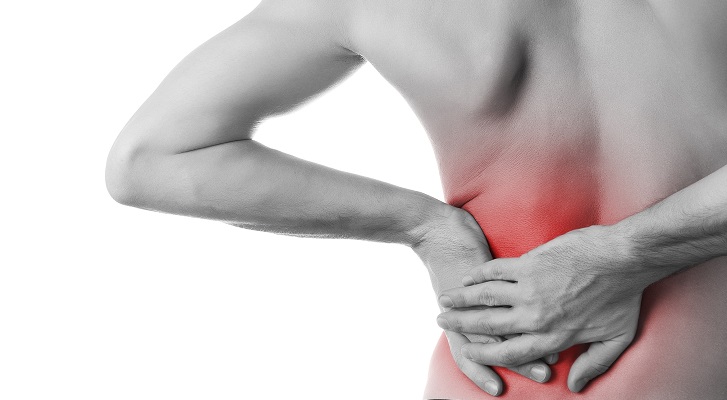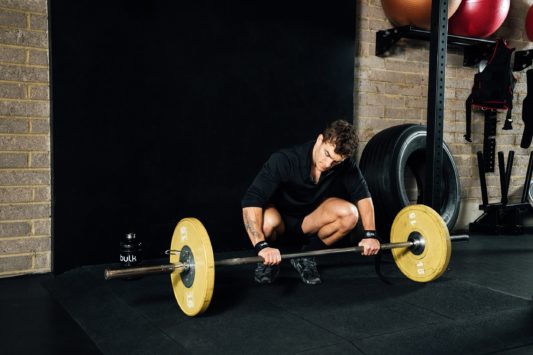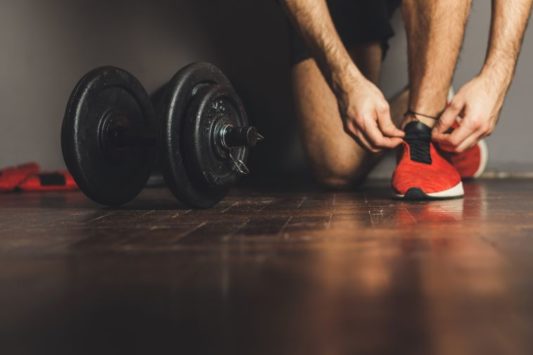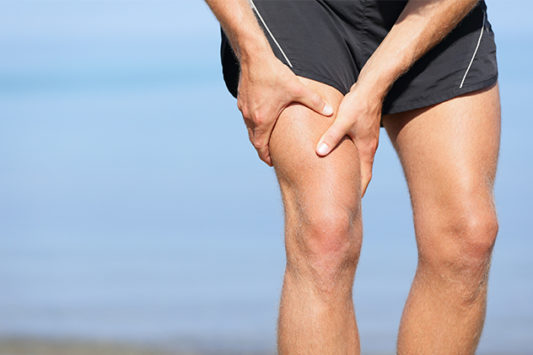You’ve probably heard people speak its name, or shudder when it’s mentioned in conversation. What is this “DOMS”, or delayed onset muscle soreness, everyone talks about? Chances are you’re a lot more familiar with DOMS than you think.
WHAT IS DOMS (DELAYED ONSET MUSCLE SORENESS)?
DOMS is an acronym for Delayed Onset Muscle Soreness and relates to the feeling we have of muscular discomfort, or muscle soreness often as a result of physical exercise – lifting weights, playing sport, or strenuous exercise.
DOMS isn’t normally felt straight after the event but is usually evident within 24-48 hours after training. You’ll often be made aware of DOMS first thing in the morning. Our bodies repair themselves as we rest and sleep, so with the body immobile for several hours while we recover, we can feel quite sore when we first wake and move about.
Common side effects include walking like John Wayne, a reduced range of motion in the affected areas, and general stiffness and muscle pain.
WHAT CAUSES DOMS?
DOMS can appear with little warning but there are a few common protagonists:
- If you are training for the first time
- If you have increased your training intensity or load
- If you are training differently from your normal routine
If you are new to exercise, you and DOMS are likely to form a very strong bond over the next few months. Some might say you’ll become inseparable. For those of you who have been training for longer, you’re probably less friendly but still meet up every now and again, especially when you feel like a bit of a change.
DOMS is linked to the body making physiological changes as a result of exercise and trauma. As we push our bodies to new limits, our muscles adapt to better prepare them for future activity. This involves the repair of muscle fibres that are damaged when we train. The metabolic process (when our body breaks down molecules for energy) can also impact the acidity levels of our muscles, leading to an increase in lactic acid, fatigue, and discomfort.
Whilst delayed onset muscle soreness is not linked to specific exercises per se, it tends to be felt most aggressively in subjects who perform eccentric exercises (where the muscle lengthens as it contracts) such as squats and is often most noticeable in the lower body because of the larger muscle groups – particularly the quads, hamstrings and glutes.
HOW CAN DELAYED ONSET MUSCLE SORENESS BE PREVENTED?
In principle, it can’t, but it can be managed better. DOMS is linked to a change in stimulus and muscle adaptation. By introducing a training plan that incorporates progressive increases in your workout load/intensity, you should be able to limit the extent to which your muscles are broken down.
Subsequently, as you become bigger and stronger you should become more efficient at recovering from exercise – but it’s unlikely that you’ll ever remain DOMS-free without reducing the intensity of your training.
Sports supplementation is one way of reducing the impact of delayed onset muscle soreness, especially when undertaking frequent and/or intensive exercise. Making sure you are eating right and getting a good supply of carbs, protein and fats is key to replenishing energy stores, building and repairing muscle and maintaining a healthy immune system.
Complete Recovery™ is the perfect choice for use immediately after intense training sessions. It is important to remember that recovery is just as important as exercise, as this is the time when your body repairs from the stress of intense training sessions. The famous saying goes that you grow outside the gym, not inside.
AFTERMATH™ contains 40g protein per serving – a blend of Whey Protein Isolate and Whey Protein Concentrate. Protein has been shown to contribute to muscle growth. In addition, pharmaceutical-grade Leucine, which is considered the key amino acid for muscle growth and protein synthesis, has been included at an unrivalled 3g per serving. An impressive 5g Glutamine Peptides have also been incorporated, supporting exercise recovery and preventing muscle breakdown.
Montmorency Tart Cherry Extract is renowned for its antioxidant content and is also considered a potent anti-inflammatory. Training with increased frequency and/or intensity can result in increased oxidative stress and inflammation as well as causing muscle damage. Research on Tart Cherry supplementation has shown reductions in inflammation, muscle damage and pain in an exercising population.
Preparing your muscles prior to exercise is also recommended. Raising your core body temperature and heart rate can also increase your general preparedness for activities ahead. Dynamic stretching prior to a workout is also suggested, rather than static stretching, as the latter can lead to a reduction in power and strength due to reduced elasticity in the muscles.
Warming down sufficiently and incorporating static stretches at the end of a workout can aid the recovery process – elongating the muscles which have contracted and shortened during training. An active warm-down will also promote blood flow and nutrient access to the muscles at the time they are needed most.
Stay hydrated. This is probably the most basic but frequently overlooked factor linked to performance. The electrolytes found in water help regulate heartbeats and muscular contractions. As soon as dehydration kicks in, performance takes a noticeable hit and if any of you have ever suffered from cramps, you’ll know that it hurts..a lot.
HOW CAN DOMS BE TREATED?
Much can be achieved by being sensible and adopting new fitness habits and routines. Prevention is the best cure, as they say.
Foam rolling has seen a significant rise in popularity over the past few years. Look inside any CrossFit box across the globe and you’ll see foam rollers of all shapes and sizes littering the floor (or cubby holes). These are also now becoming more prevalent in commercial gyms too. Much like rats, you’re only ever a few feet away from a foam roller!
Foam rolling is a popular means of self-myofascial release, the process of lengthening muscles and removing muscle knots and kinks. It’s not always the most comfortable activity, but professionals and athletes alike swear by its effectiveness. Myofascia is dense tough tissue that surrounds and covers your muscles and bones. Tissue manipulation is used for reducing muscle soreness, stress, tension, and fatigue, thus relieving pain and supporting muscle recovery.
Contrast showering is a technique only used by the bravest amongst us and involves showering in short bursts of hot water, followed by cold water and so on. This is typically done in cycles, with a standard ratio of approximately 3:1 (hot water to cold water). 3 minutes of hot water followed by 1 minute of cold water. Repeat a further 2 or 3 times.
The science behind contrast showering is simple. The hot water helps to open up the blood vessels and increase blood flow, drawing blood to the surface of the skin. Cold water is then used to drive the blood flow inwards to protect internal organs from the cold. The process is thought to aid delayed onset muscle soreness by reducing the amount of lactate in the blood and inflammation too, thus helping to relieve sore muscles.
Sports massage is another method used to aid recovery. Tissue and muscle manipulation helps to move blood and fluid which promotes the flow of nutrients to your muscles and flushes out any nasty by-products of exercise.
De-loading or non-impact exercise is also a great way of staying active whilst reducing the effects of DOMS. If you’ve ever trained hard and then done nothing the next day, day 3 can be a battle of will. Active recovery, whilst not treating DOMS in its entirety, is believed to assist in muscle recovery. For example, swimming is a great non-impact full-body exercise that gets all the energy systems working together but won’t promote further muscle breakdown.
Train different body part splits so damaged muscles have a chance to recover properly. If you trained your legs on Monday, train your upper body on Tuesday. Not only will this prevent further muscle breakdown, but it gives your body the time it needs to recover stronger, ready for your next session.
DOMS (Delayed Onset Muscle Soreness): FAQs
What gets rid of DOMS?
Some useless strategies to relieve DOMS include massaging, foam rolling, cold water immersion or contrast showering, and taking pain relievers such as Nonsteroidal anti-inflammatory drugs (NSAIDs) if muscle soreness and pain is particularly bad.
How long does DOMS last?
DOMS can typically last up to a week depending on the individual. You can reduce muscle soreness and the duration of DOMS by engaging in recovery activities such as massaging, foam rolling, and active recovery.
Is it OK to workout on DOMS?
Training at a high intensity is probably not the best idea when you have DOMS, however, training at low intensity is encouraged as this may help your recovery. Swimming, walking, or gentle cycling are good examples of active recovery and are great ways to gently ease your body back into exercise.
How painful are DOMS?
DOMS and exercise-induced muscle damage can be particularly painful for those who have engaged in strenuous exercise with a focus on eccentric muscle contractions, especially beginners. The affected muscle groups can feel stiff and tender to touch, and there is typically a reduced range of motion due to muscle soreness. Symptoms of delayed onset muscle soreness improve after a few days.
RELATED ARTICLES
Looking to learn more? We believe that every person, with support, has the right to transform their lives through fitness. That’s why we’ve put together hundreds of articles with expert advice, all to help you on your fitness journey. Here are some more articles on muscle building, fitness and training.
Best tricep exercises How to get bigger triceps
What is a dropset? Muscle building for beginners
Principles for building muscle mass Getting a six pack
Exercises to build bigger glutes What does catabolic mean?
How to choose a training split Tips for bigger biceps













